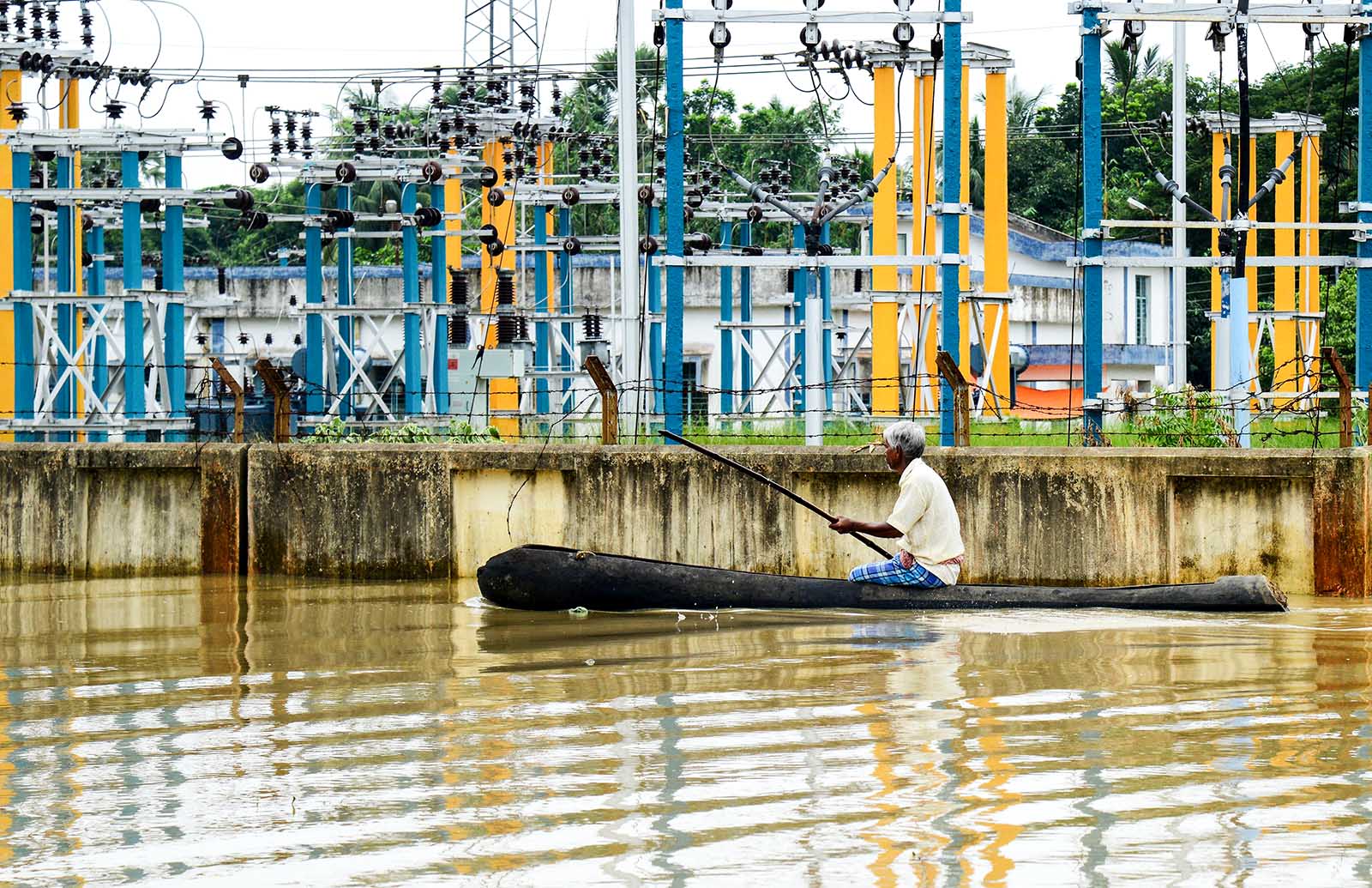Utilities and Business: How Scaling Up Energy Access Delivers ‘Wins’ for Both

A man makes his way through flood waters near an electricity plant in West Bengal, India. Over 1 billion people still lack access to electricity, mostly in Sub-Saharan Africa and India.
Photo: Dibyangshu Sarkar/AFP/Getty Images
Utilities and businesses have a symbiotic relationship. As experience demonstrates, the ability of utilities to deliver sufficient energy that is both reliable and affordable affects how efficiently businesses can operate. In turn, the balance of reliable supply and demand influences the capacity of utilities and businesses to attract investments, to deliver goods and services to their customers, and to offer other benefits to society at large. Ultimately, this relationship plays a key role in stimulating economic growth and supporting social development.
In recent decades, several countries have made significant progress in boosting access to energy, particularly in Asia and Latin America. Those that have forged ahead reinforce the fundamental importance of three elements: establishing effective regulatory structures, building technical and human capacity within the sector, and more effectively engaging with customers and stakeholders. Over 1 billion people still lack access to electricity, mostly in sub-Saharan Africa and India. Progress to scale up access—and the investment needed to support these efforts—could be accelerated if utilities and businesses collaborated to mitigate risks and realize opportunities.
Risks to Utilities and Their Customers
The reality is that businesses, whether large or small, need reliable energy to operate. If they cannot rely on utilities to provide it, they will take care of it themselves. For example, across many parts of sub-Saharan Africa, a small shop will buy a generator or a large factory will install its own power plant. In both cases, the investment is substantial in relation to the demand, and the cost drives up the prices they need to charge their own customers for goods or services. If a given business finds that customers cannot pay the higher prices, the business may become nonviable.
In the past, self-produced energy almost always carried higher costs and thus was minimally used to cover grid outages. Today, that is no longer the case: Onsite renewables may be more reliable and more cost-effective, meaning utilities in India and sub-Saharan Africa face the risk of losing the customer base that is most able to pay.
Unreliable electricity affects productivity, profits, and prospects in other ways: Outages can cause expensive equipment to malfunction and halt operations, interrupting supply of goods and services. Additionally, businesses seeking to scale up need to convince investors of their ability to deliver more goods or services, which may prove impossible if they cannot be guaranteed access to sufficient energy supply.
It must not be overlooked that unreliable energy supply also affects the delivery of basic services such as water, health care, education, and transportation. In addition to having negative consequences on the daily lives of citizens, this can stall growth in another way: Foreign companies hesitate to invest in countries where they cannot guarantee basic safety and security for employees.
Conversely, when a well-run utility delivers affordable, reliable energy, all customers have lower energy bills and more financial resources to direct to their core activities and services. So, what does it take to get “wins” all around?
A Regulatory Framework that Fosters a Business Mindset
Establishing governance and regulatory structures that strengthen the business case of the utility sector in developing countries is vital to attracting investors and realizing the opportunities of increasing energy access. Examples from many countries belonging to the Organisation for Economic Co-operation and Development show that legal/regulatory structures that allow utilities to flexibly function is vital in current electricity markets, regardless of whether utilities are owned and operated by governments or as private companies. Regulatory models need to be adaptable to accommodate the new technologies and “packages” of services that utilities are deploying to meet the particular demands of local conditions.
In sub-Saharan Africa, India, and other countries with low energy access per capita, utilities need to be more engaged in the process of developing clear and transparent regulatory frameworks, with the goal of ensuring that government action and oversight do not result in excessive interference. Fixing the governance and regulatory structure is vital to attracting investors and realizing the opportunities of increasing energy access.
To unleash economic growth through energy access, utilities need to take efficiency into account when designing viable business models for affordable and reliable supply. Adding the efficiency requirement means that past business models, based on selling more and more units of electricity, are no longer viable for expanding energy access. The old paradigm of monetizing the unit of electric energy consumed will need to be replaced; future business models should instead monetize the services that are enabled by electricity and delivered by new multi-commodity utilities. The policy and regulatory framework must adapt to support this new approach to operation.
Building Technical and Human Capacity
Countries now expanding their energy systems can leapfrog directly to more flexible and efficient technologies. Often, discussion of current gaps within the utility sector of developing countries focuses on the missing technical capacity. Today, and going forward, this must be considered in the context of much more diverse and complex systems that range from microgrids to massive installations of power plants—whether hydropower, fossil fuel, or renewable—with supply being distributed across long distances. Providing energy access for all will require a hybrid of both centralized and decentralized solutions and thus a diverse set of skills. Without question, Africa and India need to substantially boost the number and capacity of engineers and technicians who can develop, install, operate, and repair the components of both grid equipment and off-grid equipment.
As populations increase, electricity demand will rise across the board. As electrification improves, profit margins will improve in all other areas.
Several years ago, when giving a lecture at Wits University in Johannesburg, South Africa, I proposed the metric of engineer per megawatt (MW). This could be expanded to an engineering team, where each team consists of one engineer, two technicians, etc. Adapting such a metric to the goal of 40,000 MW from the Grand Inga dam in the Democratic Republic of the Congo would, for example, yield 40,000 engineers or engineering teams to maintain and maximize the life of the asset.
Increasingly, as technology advances, human capacity in digital technologies that bring new efficiencies through smart operation also will be needed. In China and Latin American countries, we see parallel efforts to develop skills on the business side, including effective management, strategic planning, resilience, and risk management, including cybersecurity.
One way to strengthen the management of utilities is to create opportunities for dialogue and an exchange of lessons learned and best practices among utility executives in developing countries and their counterparts operating more advanced utilities. Recently, such an initiative, the Africa Utility Power Sector Exchange, was launched with the aim of promoting peer-to-peer networking opportunities among utility executives in Africa and those in the United States and other countries.
Customer and Stakeholder Engagement
While building technical and human capacity can improve operations of both utilities and businesses, another important priority should be developing greater proficiency in communication with customers and stakeholders.
Utilities in India and in countries in sub-Saharan Africa, like their counterparts in other parts of the world, need to recognize that, in the future, they will be serving two main customer segments and often applying different technologies. By 2030, more people will live in urban centers than in rural areas. In many large cities in the developing world, electricity service is currently delivered via a complex system of highly intertwined (yet often unrelated) wires. These systems are characterized by high network losses, a large number of customers unable to pay according to current pricing schemes, and high levels of theft—all of which undermine profits for the utility and hamper its capacity to deliver to paying customers.
With many small, remote villages still lacking electricity, off-grid and stand-alone systems are the more viable option. At present, many of these areas are getting services, thanks to nongovernmental organizations and social entrepreneurs who see the opportunity to make electricity a locally owned and operated business. Utilities would do well to consider how they can participate in this market, particularly in countries with large rural populations.
Meeting the needs of customers in these vastly different contexts will be hugely complex. Utilities will need to strategically segment their customers according to needs (including both delivery of service and security of service) and capacity to pay, which implies a much deeper level of stakeholder engagement. They also need to better understand the value customers attach to energy services delivered.
Smart Rollout of Energy Access Creates Opportunity Across Economies
As utilities develop capacities to scale up energy access, tremendous opportunity exists in the short term to use information and communication technologies to efficiently generate and deliver electricity. Digitization is relevant to all of the pillars described above. Data-driven systems can integrate a wide range of technologies to improve the efficiency of grid infrastructure, thereby ensuring more reliable delivery of electricity to customers. Importantly, they also bring the ability to learn about customers at a much more granular level, allowing utilities to be more responsive and customize their supply of services in relation to demand.
In the long term, global efforts to achieve universal access to clean energy create remarkable opportunity for investment, initially in the utilities sector but ultimately in all sectors that rely on electricity, including public services (health care, education, etc.), industry, agriculture, and services sectors. As populations increase, electricity demand will rise across the board. As electrification improves, profit margins will improve in all other areas.
Currently, there is an interesting dichotomy that relates to energy access, regulatory frameworks, and investments. In many developing countries, the projected demand growth is not yet supported by regulatory frameworks that ensure reliable supply. As a result, there is not enough stability to secure investments. Conversely, where regulatory systems have become effective—primarily in industrialized countries—despite global economic growth, electricity demand is flat or declining. Utilities in such contexts are searching for new growth opportunities and even exploring other business lines.
This dichotomy reinforces that, whether state-owned or private companies, utilities need to operate on sound business principles and that regulatory and policy certainty are vital. A noteworthy example in Africa can be found in Cote d’Ivoire. With the government providing the right policy signals and regulatory certainty, La Compagnie Ivoirienne d’Electricité (CIE) has become one of the most successful utilities in sub-Saharan Africa. Within this regulatory context, the company established a multi-ownership structure with the majority share owned by a private investor. Remaining shares are held by the government, employees, and citizens who can buy shares on the stock market. This unique, flexible ownership model has become a win-win for multiple stakeholders, prompting a significant increase in CIE share prices. Under this model, executives are accountable to all stakeholders—government, shareholders, businesses, customers, and society in general. This CIE example demonstrates that, with the right structures in place, investing in energy access can benefit utilities, businesses, and, more importantly, customers and society at large.
With the right legal and regulatory frameworks in place and supported by strong collaboration between utilities and businesses, investing in energy access in developing countries could be a remarkable new growth frontier.
In partnership with:
BRINK, in collaboration with The Energy Action Project and Edison Electric Institute, produced this article as part of a series to investigate why energy access matters to the business community. Energy and research agencies estimate that between $768 billion and $1.2 trillion is needed to achieve universal access to energy by 2030. The series explores opportunities for return on investments and the risks society faces if we don’t address energy poverty. Other articles in this series include:
- Energy Access is Critical to Economic Growth
- Energy for Education Is Vital for Developing Economies
- Basic Energy Need Makes for Big Market Opportunity





